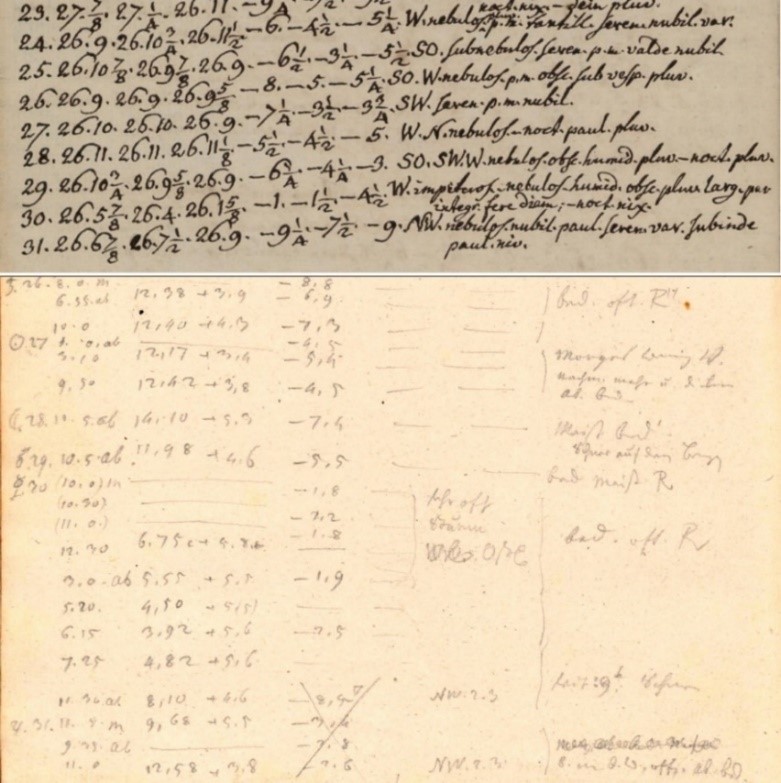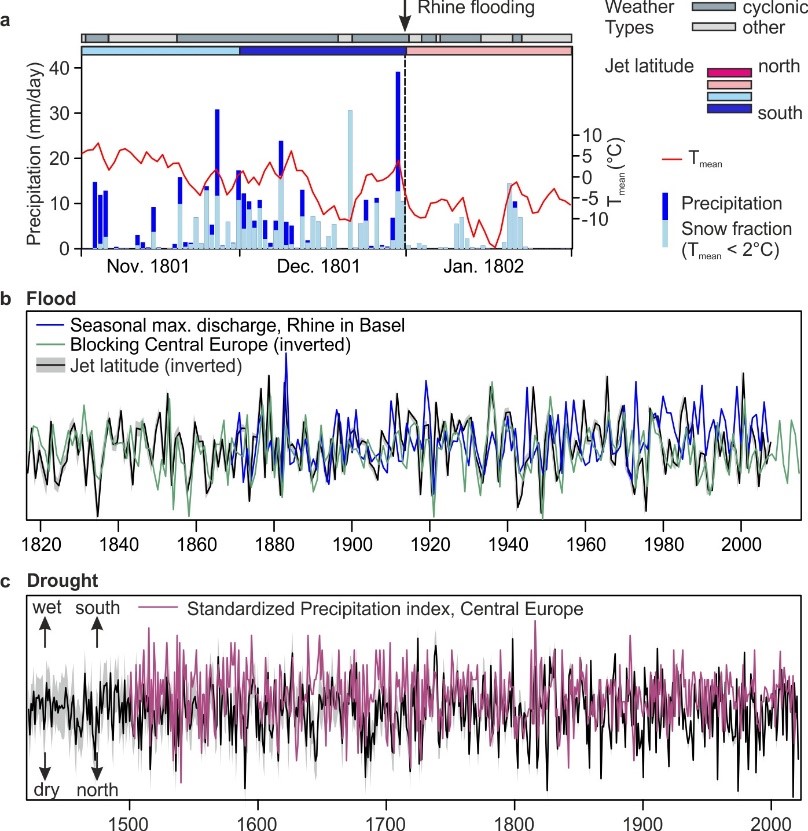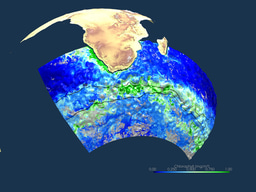The jet stream, floods, and droughts in Central Europe: A six-hundred year perspective
Published in Earth & Environment
In July and August 2022, Europe experienced extreme heat and severe drought (Fig. 1), possibly one of the worst in centuries. This led to low river flows across the continent, affecting the energy sector (particularly hydropower generation and cooling water for other power plants) and agriculture, which suffered from low crop yields. There were more wildfires, and a study found that over 60,000 people died from the heat [1]. After an already dry spring, the weather was dominated by anticyclonic conditions during the summer and the jet stream was displaced to the north.
_1.jpg)
On New Year's Eve 1801, the city of Basel in Switzerland was hit by an extreme flood of the Rhine river [2]. The event was among the dozen or so largest floods since the 14th century. Weather observations from Basel (sheets from two observers, Johann Jakob d'Annone and Daniel Huber, are shown in Fig. 2) indicate heavy precipitation and rather high temperatures (5-9 °C) in the days before the event. From these data and numerous other series, we can reconstruct the daily weather with high spatial resolution [3]. These reconstructions, averaged over the Basel Rhine catchment (Fig. 3, top), confirm that precipitation had been high since mid-November. Much of it may have fallen as snow, but with rising temperatures, snowmelt probably had led to high water levels and saturated soils, on which massive rain fell on 30 December. A reconstruction of daily weather types [4] shows that cyclonic weather types persisted from mid-November to the end of the year. Presumably, central Europe was affected by strong troughing, and the jet stream was displaced to the south.
Reconstruction of atmospheric circulation
Droughts and floods of this magnitude are rare, and the observations from recent decades that we usually analyse do not include many of them. It is therefore important to study past events and their relation to changes in the Atlantic-European jet stream. This is especially important as both types of events have recently become more common and it is thought that they will become even more severe with climate change. But how can we study past changes in the jet stream?

D’Annone and Huber were not the only ones to observe the weather. By combining the series from many observers with documentary information (e.g., on the freezing dates of rivers or grape harvest dates) and climate proxies such as tree rings, we can reconstruct not only temperature or drought, but also the atmospheric circulation back in time. This is done by combining the observations and proxies with climate model simulations using offline data assimilation techniques. In short, we adjust the model simulations such that they match the observations within their error bars. The resulting reconstructions of global, monthly three-dimensional fields [5] allow us to analyse important features of the large-scale atmospheric circulation such as the jet stream or the monsoon systems.
Jet variations
We define three indices to describe the eddy-driven jet stream over the North Atlantic-European sector in every month: strength, tilt, and latitude. Our reconstructions agree with previous indicators of the strength of the westerly circulation or the jet latitude in summer but provide a far more comprehensive view of the global, monthly, 3-dimensional circulation. We can use these three indices to understand how the jet has changed over the last 600 years [6]. Furthermore, we find that hydroclimatic extremes found in historical records of droughts [7] and floods [2] are linked to the jet variability. Similar as for the summer of 2022 and the winter of 1801, summer droughts often occur with a poleward shifted jet and winter floods with a southward shifted jet. Changes in jet strength and tilt also matter for weather and climate extremes.

This helps us to understand how jet variations and extremes are related, and to put recent and future changes into context. We can also use long records of jet variability to analyse possible drivers. In our study, we find that the jet latitude is related to anomalies in sea surface temperature in the months before, including El Niño/Southern Oscillation. Strength and tilt are also affected by volcanic eruptions. But most of the jet's changes are due to unforced variability. What about trends? Although recent decades exhibit some extreme deviations such as a strong jet in the cold season, there are no clear long term trends. Recent trends are within those we find during past centuries.
It is fascinating to make the past weather, day by day, month by month, accessible to quantitative analysis and diagnosis as far back as several hundred years. It is astonishing that such elusive phenomena as the ever-changing weather have left enough traces for us to be able to reconstruct them today. For that we need sophisticated methods such as combining archives of nature and archives of society with the physics encapsulated in climate model simulations. D'Annone and Huber would be amazed to see that more than two centuries later, scientists would delve into the detailed mechanisms behind this flood event and obtain new insights about the large-scale circulation and its effect on flood events.
Link to the paper: https://www.nature.com/articles/s41561-025-01654-y
Check out the data set with "ClimeApp": https://mode-ra.unibe.ch/climeapp/
References
[1] Ballester, J. et al. Heat-related mortality in Europe during the summer of 2022. Nature Medicine 29, 1857–1866 (2023).
[2] Wetter, O. et al. The largest floods in the High Rhine basin since 1268 assessed from documentary and instrumental evidence. Hydrol. Sci. J. 56, 733–758 (2011).
[3] Imfeld, N., Pfister, L., Brugnara, Y. & Brönnimann, S. A 258-year-long data set of temperature and precipitation fields for Switzerland since 1763. Clim. Past 19, 703–729 (2023).
[4] Pfister, L., Wilhelm, L., Brugnara, Y., Imfeld, N. & Brönnimann, S. Weather type Reconstruction using Machine Learning Approaches. Weather Clim. Dynam. (accepted) (2025).
[5] Valler, V., et al. ModE-RA - a global monthly paleo-reanalysis of the modern era (1421-2008). Sci. Data 11, 36 (2024).
[6] Brönnimann, S. et al. (2025) Past hydroclimate extremes in Europe driven by Atlantic Jet stream and recurrent weather patterns. Nature Geoscience (accepted).
[7] Glaser, R. & Kahle, M. Reconstructions of droughts in Germany since 1500 – combining hermeneutic information and instrumental records in historical and modern perspectives. Clim. Past 16, 1207–1222 (2020).
Follow the Topic
-
Nature Geoscience

A monthly multi-disciplinary journal aimed at bringing together top-quality research across the entire spectrum of the Earth Sciences along with relevant work in related areas.
Related Collections
With Collections, you can get published faster and increase your visibility.
Geology of the Moon
Publishing Model: Hybrid
Deadline: Jan 31, 2026
Progress towards the Sustainable Development Goals
Publishing Model: Hybrid
Deadline: Ongoing






Please sign in or register for FREE
If you are a registered user on Research Communities by Springer Nature, please sign in